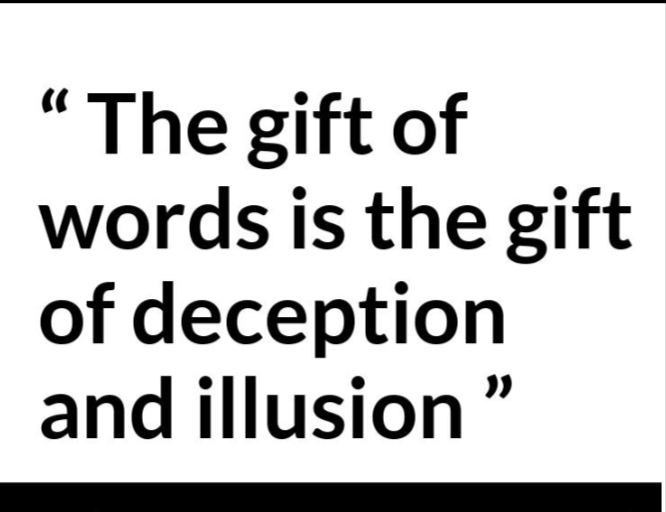
The Linguistic Trap: How Shortcuts in Language Distort Our Judgment of Reality
By Brian Britton French
In the beginning was the Word, and the Word was with God, and the Word was God. John 1:1
Language is one of humanity’s most powerful tools, enabling us to communicate complex ideas, share knowledge, and build societies. Yet, the very efficiency that makes language so effective—its ability to compress intricate concepts into simple terms—can lead to significant errors in how we perceive and judge reality. Words like “vaccine,” “natural,” or “freedom” act as linguistic shortcuts, carrying implicit assumptions that shape our understanding, often at the cost of the precise truth.
These shortcuts, while rooted in our evolutionary need for rapid decision-making, can oversimplify complex truths, leading to misinformed judgments, polarized debates, and eroded trust. This article explores how linguistic shortcuts distort our perception of reality, using the example of “vaccine” to illustrate the problem, and argues for a shift toward spectrum-based thinking in an era where precision matters more than ever.
The Power of Linguistic Shortcuts
At its core, language is a system of symbols designed to convey meaning quickly and efficiently. Words are not neutral; they carry emotional, cultural, and historical baggage that shapes how we interpret them. This is particularly true for linguistic shortcuts—terms or phrases that distill complex ideas into digestible forms.
These shortcuts are powerful because they reduce cognitive load, allowing us to process information without delving into every detail. However, this efficiency comes at a cost: by simplifying reality, shortcuts can obscure critical nuances, leading to errors in judgment.
Consider the word “vaccine.” To many, it conjures images of medical triumphs—the eradication of smallpox, the near-elimination of polio, or the rapid development of COVID-19 vaccines that curbed a global pandemic. The term is imbued with a sense of safety, efficacy, and societal good, reinforced by decades of public health campaigns.
Yet, this positive framing can overshadow the reality that vaccines, like all medical interventions, exist on a spectrum of benefits and risks. By labeling something a “vaccine,” we risk anchoring our perception to its benefits while downplaying potential side effects, leading to an incomplete or biased understanding of its true impact.
This phenomenon extends beyond vaccines. Words like “natural” imply safety or purity, yet natural substances like arsenic or botulinum toxin are deadly. “Terrorist” evokes a clear villain, but its application can oversimplify geopolitical conflicts, ignoring underlying causes or moral ambiguities. “Freedom” sounds universally positive, but its meaning varies widely depending on context, often masking trade-offs like security, practical compromise or civility.
These shortcuts shape our worldview by framing complex realities in binary or overly simplistic terms, a tendency rooted in our evolutionary past.
The Evolutionary Roots of Shortcuts
To understand why linguistic shortcuts persist, we must look to human evolution. Early humans faced a world of immediate dangers—predators, rival tribes, scarce resources—where survival often depended on split-second decisions. Was that rustle in the bushes a lion or the wind? Was that stranger a friend or a foe? The brain evolved to favor quick, heuristic-based thinking, prioritizing speed over precision.
Language developed to support this, compressing complex observations into actionable terms. A single word like “danger” could convey enough to trigger a life-saving response, without the need for a detailed analysis of the threat.
This evolutionary wiring made linguistic shortcuts adaptive. If you hesitated to categorize a shadow as a predator, you might not survive to pass on your genes. Similarly, early human communities benefited from shared, simplified terms that fostered group cohesion and rapid communication. Words like “food,” “enemy,” or “safe” allowed groups to act collectively without getting bogged down in nuance.
However, the modern world is vastly different. Most decisions we face today—whether about medical treatments, public policies, or social issues—do not require instantaneous action. Instead, they demand careful consideration of long-term consequences, probabilities, and trade-offs.
A vaccine’s efficacy, for example, isn’t a simple yes-or-no proposition; it involves weighing clinical trial data, population-specific risks, and individual health factors. Yet, our brains, still wired for survival-driven cognition, gravitate toward the same linguistic shortcuts that served our ancestors, often at the expense of accuracy.
The Case of “Vaccine”: A Linguistic Shortcut in Action
The word “vaccine” is a textbook example of how linguistic shortcuts can distort our judgment. Historically, vaccines have been among medicine’s greatest achievements. The smallpox vaccine eliminated a disease that once killed millions, and the polio vaccine transformed a crippling illness into a rarity. These successes have cemented “vaccine” as a term synonymous with progress and safety.
Public health campaigns reinforce this by emphasizing phrases like “vaccines save lives,” which, while true in many contexts, can create an impression of universal, risk-free benefit.
In reality, vaccines are not monolithic. They are pharmaceutical interventions, each with its own profile of efficacy, safety, and side effects. For instance:
- The polio vaccine has been a global success, reducing cases by over 99.9%, but rare instances of vaccine-derived poliovirus have caused outbreaks in certain regions.
- The COVID-19 vaccines significantly reduced hospitalizations and deaths (e.g., over 90% efficacy against severe outcomes in early trials), but rare side effects like myocarditis (in young males with mRNA vaccines) or blood clots (with AstraZeneca’s vaccine, ~1 in 100,000 cases) have been documented.
- The HPV vaccine prevents cervical cancer but can cause side effects like fainting or, in rare cases, allergic reactions.
A scientifically valid evaluation of any vaccine requires analyzing its benefits and risks on a spectrum. This involves:
- Benefits: Quantifiable outcomes like disease prevention rates, reduced mortality, or herd immunity.
- Risks: Side effect frequencies, which vary by vaccine, population, and administration method.
- Context: Factors like age, health status, or disease prevalence influence the risk-benefit ratio. For example, a vaccine’s value is higher for high-risk groups but may be less critical for low-risk populations.
Yet, the word “vaccine” doesn’t inherently prompt this nuanced analysis. Its positive connotation can lead to assumptions of blanket safety, discouraging questions about specific risks. Conversely, when side effects emerge, those who trusted the shortcut may feel betrayed, fueling skepticism or distrust in institutions.
This dynamic has been evident in debates over COVID-19 vaccines, where the term “vaccine” became a lightning rod, polarizing discussions into pro- and anti-vaccine camps rather than fostering reasoned dialogue about specific vaccines’ merits and drawbacks.
The Broader Costs of Linguistic Oversimplification
The distortions caused by linguistic shortcuts extend beyond vaccines, affecting how we navigate complex issues:
- Polarization: Terms like “vaccine” or “climate change” become ideological battlegrounds. Questioning the former risks being labeled “anti-science,” while debating the latter can brand one a “denier,” stifling legitimate discussion.
- Misinformed Decisions: Simplified language can lead to blind trust or unwarranted fear. For instance, assuming all “natural” remedies are safe may lead to harmful choices, like using untested herbal treatments over proven drugs.
- Erosion of Trust: When shortcuts obscure risks or uncertainties, their exposure can undermine faith in experts or institutions. The 1976 swine flu vaccine campaign in the U.S., which was halted due to rare neurological side effects, damaged public trust for years.
These costs are amplified in the information age, where media, social platforms, and public campaigns rely on catchy, simplified messaging to capture attention. “Get vaccinated” is more compelling than “Evaluate the risk-benefit profile of this vaccine based on your health and local epidemiology,” but it sacrifices precision for impact.
Moving Toward a Spectrum of Truth
To mitigate the errors induced by linguistic shortcuts, we must prioritize precision and nuance in how we communicate and think:
- Reframe Language: Replace absolute terms with spectrum-based descriptions. Instead of “vaccines are safe,” say “most vaccines have a favorable risk-benefit profile, but risks vary by individual and context.”
- Encourage Critical Thinking: Educate people to ask for data—efficacy rates, side effect frequencies, and population-specific outcomes. For example, understanding that a vaccine’s benefit is higher for the elderly during a pandemic can clarify its value.
- Acknowledge Trade-offs: Public health messaging should be transparent about uncertainties and risks, even if it complicates the narrative. Honesty builds trust more than oversimplified slogans.
- Contextualize Historically: Recognize that linguistic shortcuts are a legacy of our survival-driven past. By understanding their evolutionary roots, we can consciously shift toward deliberate, evidence-based thinking.
Linguistic shortcuts, like the word “vaccine,” are double-edged swords. They enable rapid communication, a trait that was critical for survival in humanity’s past, but they can distort our judgment of reality in a world where nuance matters more than speed. The term “vaccine” illustrates this perfectly: its positive connotations can obscure the need for a spectrum-based evaluation of benefits and risks, leading to polarized debates and misinformed decisions.
By recognizing the evolutionary roots of these shortcuts and embracing precise, data-driven communication, we can align our language—and our thinking—with the complexities of modern reality. In an era where truth is paramount, moving beyond linguistic shortcuts is not just a linguistic challenge but a societal imperative.



